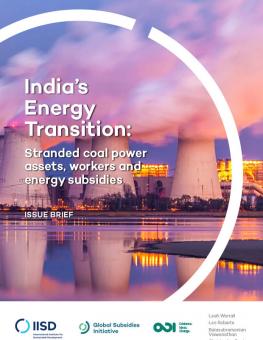
India's Energy Transition: Stranded coal power assets, workers and energy subsidies
What is driving stressed coal power assets in India, and how do we ensure workers, not assets, are the focus of government interventions in the future?
What is driving stressed coal power assets in India, and how do we ensure workers, not assets, are the focus of government interventions in the future?
Key Messages
- India's 2018 crisis of stressed coal power assets may rear its head in future years as various drivers suggest increased coal power costs in the future. Government interventions should not only focus on the short term, they also need to support a managed transition fair for all involved, including workers.
- Current drivers of stressed assets include coal shortages and the financial distress of energy distribution companies (DISCOMs), while future drivers are likely to include water scarcity, air pollution regulations and cost-competitiveness of renewables.
- Policy support mechanisms for coal artificially dampen market signals that affect coal power costs. These take the form of subsidies, public finance through loan preferential rates, or the delay or lack of enforcement of policies (such as air pollution regulations) that would otherwise increase costs to producers.
- As part of an ongoing dialogue about labour in the coal sector, policy-makers should consider the complementary policies that can ensure that the burden of asset stranding does not fall on workers and communities. This might include general employment schemes, targeted social protection measures and financing mechanisms.
In the India Energy Transition 2018 update, the Global Subsidies Initiative (GSI) of the International Institute for Sustainable Development (IISD) and the Council on Energy, Environment and Water (CEEW) published updated estimates of the scale of energy subsidies in India for FY 2017, including partial data on the scale of subsidies for FY 2018.
One of the review's striking findings was government support measures for coal have remained largely unchanged since 2014, despite an ongoing crisis in the coal sector, where around 18 per cent of installed capacity is "stressed" and at risk of entering bankruptcy proceedings.
This issue brief takes a detailed look at why such a large share of coal power is struggling today and the drivers—including subsidies—that may cause similar crises to rear their heads in future. In light of this, it sets out some broad proposals from international literature on the topic of “just transition,” which encourages governments to recognize stranded workers and communities as much as stranded private or public assets. It builds on an analysis of the relationship between subsidies and coal power assets published by the GSI and the Overseas Development Institute in mid-2018, India’s Stranded Assets: How Government Interventions Are Propping Up Coal Power.
Participating experts
You might also be interested in
G20 energy ministers call for cooperation on nuclear energy & low-emission hydrogen
The Group of 20 energy ministers' meeting concluded in Goa on July 22, 2023, with the final summary failing to include language on the phase-down of unabated fossil fuels.
Fighting for a place to breathe
In the shadow of a retired coal-fired power plant in India's capital, Meena Devi tries to make her family home -- four brick walls with a tin roof -- a safe place to breathe.
Subsidies for renewable energy and EVs more than double: Study
Nagpur: India’s subsidies for renewable energy and electric vehicles more than doubled this fiscal, according to a new study by independent think-tank International Institute for Sustainable Development (IISD). However, it also found that it will be critical for the government to build this momentum over the coming years to reach the country's climate targets.
EV subsidies in India doubled in FY 2022: IISD report
According to a recent study conducted by IISD (International Institute for Sustainable Development) subsidies for renewable energy and EVS in India have more than doubled in FY 2022. India still allocated four times more support to fossil fuels than clean energy, although the gap narrowed significantly since FY 2021 when support was nine times greater.